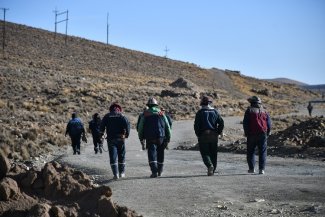The brightly coloured houses, the parks and busy terraces of Cottbus soon make you forget you are in the middle of the Lusatia mining region in eastern Germany. But the German government’s decision to close the old lignite-fuelled power stations is a worry for many of the city’s 100,000 inhabitants.
Berlin has, in fact, committed to reducing CO2 emissions 40 per cent by 2020, compared with 1990 levels. Yet the country still relies on highly-polluting coal combustion for over 40 per cent of its electricity.
By 2019, eight production units have to be removed from the electrical grid. They will, however, be kept on standby for four years, ready to be re-launched if need be.
In Lusatia, it is the Jänschwalde power plant, 15 kilometres from Cottbus, that has to cut its pace. With a capacity of 3000 MW, it is one of Europe’s biggest, and most polluting, power plants.
It emits 26 million tons of CO2 every year. Two of its six production units will therefore be closed in 2018 and 2019.
“The government’s decision is a worry for my constituents because the coal industry is vital to the region,” explains Holger Kelch, the mayor of Cottbus. In former East Germany, where the economy largely suffered following reunification, doing without an employer like Vattenfall, the owner of Lusatia’s mines and power plants, is not easy. The Swedish company directly employs 8,000 people in the region. Another 9,000 are employed by its subcontractors.
To compensate for the closure of the power stations, the German state plans to pay out a total of €1.6 billion (US$1.8 billion) to the companies concerned. The measure was approvedat the end of May by the European Commission, which concluded that the “potential distortions of competition created by the aid are largely offset by the environmental benefits”.
Thanks to this money, no redundancies are planned at Vattenfall in Lusatia.
“But workers leaving through retirement are not being replaced,” regrets Philipp Zirzow of the mining, chemical and energy workers’ trade union IG BCE. “Moreover, no aid will go to the subcontractors. We think around a thousand jobs will be lost.”
“People here defend coal”
Although the blow is bearable, it is probably just the beginning. After phasing out nuclear power by 2022, Germany wants to take on coal. In January, the environment minister, Barbara Heindricks, announced that plans were being drawn up to phase out this fossil fuel by 2050.
Coal is by no means popular among the public. According to a survey published in 2015, 68 per cent of Germans would like to see an end to it by 2035.
In May, 3,500 activists gathered in Lusatia to block power plant operations. Their action was widely frowned upon by the region’s inhabitants.
“Most people here support coal,” says professor Harald Schwarz, an energy specialist at the University of Technology - Cottbus-Senftenberg. “During big demonstrations of this kind, only a third of the participants come from Lusatia.”
The scientist argues, moreover, that phasing out coal will take at least 40 to 50 years.
The fact is that solar power and wind power do not produce energy continuously. Electricity therefore needs to be stored during peak production so that it can be injected into the grid when required.
“But it will take 30 years to develop storage capacity on a large scale,” predicts Schwarz. “Until then, we will not be able to close any conventional power plants.”
The trade unions hold the same view: “The energy transition is a good thing, but it costs a lot of money,” insists Philipp Zirzow.
“Lignite is the most affordable source of energy on the market, along with nuclear, and it has the advantage of being extracted in Germany. So it allows us to avoid too big an increase in electricity prices, which would be disastrous for our industries.”
The city hall is nonetheless already preparing for a future without coal. For the mayor, Holger Kelch, improving the city’s image, to attract new residents and visitors, is crucial: “We have to develop the sports and cultural amenities. A former mine in Cottbus has been turned into a huge artificial lake.” But tourism alone cannot replace industrial employment.
“We are also trying to facilitate the establishment of new companies. For example, we managed to grant a logistics company a building permit within the space of six weeks. The boss said he’d never seen anything like it in the rest of the country.”
Wolfgang Krüger, president of the Cottbus Chamber of Commerce and Industry, believes the region’s companies primarily need help to free themselves from their dependence on coal.
“Many companies here operate as subcontractors or service providers for Vattenfall. They need to start redeploying their businesses right now and to develop new products or services.”
“But it is a very difficult process. Of the 37,000 companies that are members of our Chamber, the majority only employ between 15 and 20 people, so they have very limited equity and capacity for innovation.”
The Chamber of Commerce and Industry has therefore teamed up with the University of Technology, the Chamber of Crafts and two local business associations to found the Innovationsregion Lausitz (Lusatia Innovation Region) enterprise.
Equipped with a million euros and four employees, this structure is tasked with finding solutions to prepare for the region’s economic transition.
Hans Rüdiger Lange, a former Vattenfall employee, is heading the operation.
“We’ve held in-depth discussions with the companies directly affected by the closure of the coal plants, to understand their concerns and their expectations,” says the energy economics expert. “We have also held workshops to help them develop new strategies and turn towards new markets.”
Lange and his team have already supported very concrete redeployment projects.
They are working, for example, with an industrial climbing company, specialised in works on the towers and stacks of coal-fired power plants. The company has teamed up with a local start-up and is now turning towards wind turbine cleaning services.
“We are also working with the Cottbus University of Technology,” adds Lange. “We are connecting research teams with companies to help them develop.”
With its 8,200 students, the university is often seen as a key player in Lusatia’s future development.
“There is great potential for innovation,” rejoices the mayor of Cottbus, who also hopes the university will play a role in developing a solution for the storage of electricity.
Yet in spite of all these encouraging projects, the region’s future remains largely uncertain. Kelch nonetheless refuses to succumb to pessimism. In his view, there is definitely life after coal, even in Lusatia.








